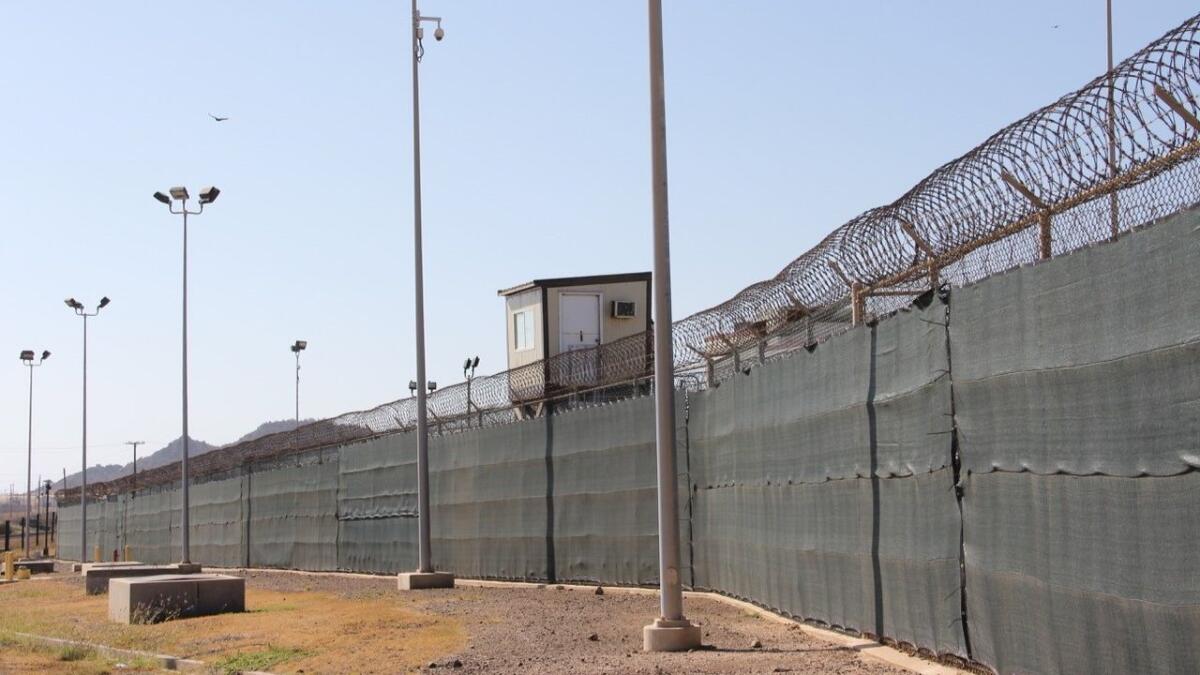Trump’s Guantanamo Bay order may be largely symbolic, but it renews debate

- Share via
To many in and outside the United States, the military prison at Guantanamo Bay, Cuba, has long been a blot on America’s stated democratic ideals, a facility closely associated in the public mind with orange jumpsuits, waterboarding and hunger strikes.
Soon after taking office in 2009, President Obama declared he would shut down Guantanamo, although he didn’t succeed in doing so. President Trump, in his first State of the Union address, defiantly announced that the facility would remain open, in keeping with campaign pledges and an apparent determination to reverse as many of his predecessor’s policies as possible.
Trump’s announcement, codified in an executive order signed shortly before his address to Congress on Tuesday night, leaves open the question of what’s next for the prison and those held there. Here’s some background:
How did Guantanamo come into being?
U.S. Naval Station Guantanamo Bay, at Cuba’s southeastern tip, sits on land leased under the Cuban-American treaty of 1903. A detention camp was constructed there in stages after the Sept. 11 attacks to hold designated “enemy combatants” — terrorism suspects captured on the battlefield in Afghanistan — rather than bring them to the United States for trial. The first prisoners arrived in 2002, and since then more than 750 detainees, from teenagers to octogenarians, have passed through the facility, colloquially known as “Gitmo.”
Where did the Guantanamo inmates come from?
Only about 5% were captured on the battlefield. Many others were caught by bounty hunters, or handed over to U.S. forces by rival warlords or simply neighbors with a grudge. Opponents of the Guantanamo detentions said important figures were far outweighed by ordinary foot soldiers. Probably the best known detainee is accused 9/11 mastermind Khalid Shaikh Mohammed.
How many prisoners are there now?
With no new arrivals in a decade, the facility’s population has dwindled to 41. When Trump assumed office, five of those had been cleared for release. Twenty-three have not been charged with any crime, according to the American Civil Liberties Union. The prison costs more than $440 million annually to operate, working out to a cost of nearly $11 million per detainee.
Why is the facility controversial?
Practices have varied over the years, but suspects have very few legal rights, and accounts have frequently surfaced of methods widely seen as torture — sleep deprivation, denial of food and water, beatings, isolation and exposure to extremes of heat and cold.
Why was Obama unable to make good on his promise to close Guantanamo?
It was a long and complicated saga that lasted his entire presidency. Obama largely blamed Congress, but one significant obstacle was foreign governments refusing to accept custody of those the United States wanted to release. The Pentagon also raised roadblocks.
What does Trump’s executive order say?
The president gave Defense Secretary James N. Mattis 90 days to hold consultations and come up with a new policy for military detentions. “Terrorists are not merely criminals; they are unlawful enemy combatants,” Trump declared in his speech. “When they are captured overseas, they should be treated like the terrorists they are.”
What has Trump said about Guantanamo in the past?
On the campaign trail and as president-elect, he railed against the release and transfer of prisoners from Guantanamo. Most of these — 532 — were made under President George W. Bush, and 197 by Obama. Trump has praised the facility as an appropriate destination for “bad dudes,” and last year raised the prospect of sending Uzbek national Sayfullo Saipov, the suspect in a truck attack on a Manhattan bike path that killed eight people, to Guantanamo. The idea, which legal experts said would have been highly complicated, was dropped.
What has been the reaction to Trump’s announcement?
The president’s remarks on Guantanamo won warm applause from Republican lawmakers, and his backers see his declaration as keeping with a hard line on terrorism. Critics say it fits with a pattern of animosity toward Muslims and disregard for the rule of law. The group Physicians for Human Rights called the facility a “symbol of U.S. torture and injustice known around the world.” Former U.N. Ambassador John Bolton, a Trump supporter, praised the decision on Twitter, saying it reflected the embracing of a “war paradigm” for dealing with terrorism suspects.
What rationale did Trump offer for keeping prisoners at Guantanamo?
Speaking generally about the topic of dangerous figures being released, Trump cited the case of Islamic State leader Abu Bakr Baghdadi, who was not held at Guantanamo. He was held in U.S. custody in Iraq, but was released. Trump’s reason for keeping the facility open revolved mainly around notions of well-deserved punishment. “Terrorists who do things like place bombs in civilian hospitals are evil,” Trump said in his speech. “When possible, we have no choice but to annihilate them.”
Who might end up at Guantanamo now?
No new detainees have arrived since Trump took office, nor have any been released. The executive order stipulates that U.S. authorities “may transport additional detainees to U.S. Naval Station Guantanamo Bay when lawful and necessary to protect the Nation.” But in recent years, U.S. federal courts have proved a much more fruitful venue for trying terrorism cases, with more than 500 such prosecutions taking place since the Sept. 11 attacks. The military commissions at Guantanamo have convicted eight, and four of those were overturned on appeal.
More to Read
Sign up for Essential California
The most important California stories and recommendations in your inbox every morning.
You may occasionally receive promotional content from the Los Angeles Times.










